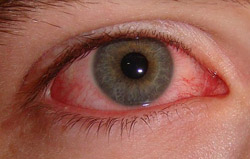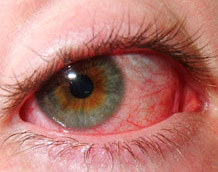Conjunctivitis is one of the common eye diseases with inflammation of the mucous membrane covering the white of the eyes and the inner side of the eyelids called conjunctiva. Conjunctivitis in the eye may result due to various reasons. Infectious agents (bacterial, fungal, viral), allergic reactions or chemical irritants such as air pollution, smoke, noxious fumes can cause eye infection. The infectious (viral or bacterial) type of conjunctivitis is commonly known as “pink eye”. The inflammation usually may start in one eye and later on spread to the other eye also. It’s not a serious condition, but it can be irritating and the person may feel uncomfortable. Conjunctivitis is a contagious condition, which can cause major outbreaks. The three major types of conjunctivitis are bacterial conjunctivitis, viral conjunctivitis and allergic conjunctivitis. Conjunctivitis symptoms include redness of eye, increased amount of tears, itchy eyes, thick yellow discharge which gets sticks while closing the eyes, blurred vision, burning eyes. Most of the conjunctivitis do not require treatment and resolve in few weeks. The general remedies for the eye with conjunctivitis are hygiene of the eyes and rest to the eye.

Bacterial conjunctivitis:
It is the bacterial infection of the eye caused by staphylococci, streptococci or haemophilus. Since bacterial conjunctivitis is a contagious eye infection these organisms may come from another person with conjunctivitis or from the patient’s own skin or upper respiratory tract. Pink eye is the commonest symptom of bacterial conjunctivitis.
Bacterial conjunctivitis treatment: Most common cases of infective conjunctivitis do not require medical treatment and may heal in one to two weeks. The eyes should be kept clean with cotton wool soaked in cooled boiled water to remove any crusts or stickiness. Broad spectrum antibiotic drops or ointments can also be used under medical prescription.
Viral Conjunctivitis:
It is the infection of the conjunctiva of the eye with virus and is commonly associated with an infection of the upper respiratory tract, common cold or a sore throat. This is commonly known as pink eye, and the symptoms of viral conjunctivitis are diffused pink colour of the conjunctiva and acute follicular reaction. The causative organism may be a virus called ‘adenovirus’. The epidemic of viral conjunctivitis of the eye occurs due to the rapid spreading of the virus between people.
Treatment: Viral conjunctivitis has no effective treatment. It is important to ensure a strict hygiene because of its highly contagious condition. The eyes may be made comfortable by using cold compresses, lubricant ointments and tablets, such as paracetamol and ibuprofen that can help cure the symptoms.
Allergy Conjunctivitis:
The individuals with other allergic disease, such as hay fever, asthma and eczema have a high chance of developing allergy in the eye. The common cause of this type of eye allergy is antigens like pollen, dust mites or cosmetics. Eye allergy symptoms are the response of histamines released during the allergic reaction. They red eye, itching, increased lacrimation are common symptoms of eye allergy. Pink eye from allergy is not contagious.
Treatment: The eye allergy can be prevented by the use of eye drops such as sodium cromoglicate and for getting better results; they need to be used for many weeks. Corticosteroid drops can be used occasionally for allergy in eyes, under the supervision of an ophthalmologist. The foremost treatment is to identify and avoid the allergen that trigger off the allergic response.
Uveitis
Uveitis is inflammation of the middle layer of the eye called uvea or the uveal tract. The inflammation of the uvea may be painful and results in red eye, mostly with cloudy vision. The major veins and arteries within the uvea channelize the blood to the parts of the eye that are vital for vision. So any damage or blockage to this passage directly affects vision. The potential factors causing uveitis of the eye include infection due to a virus, fungus, bacteria or parasite, inflammation in other parts of the body, or injury to the eye, exposure to toxins etc. The common autoimmune disorders such as rheumatoid arthritis or ankylosing spondylitis can cause uveitis. Other infections such as psoriasis and psoriatic arthritis can lead to eye inflammation. There are different types of uveitis. A form of anterior uveitis and refers to as iritis is the inflammation of the iris of the eye. Iritis is the commonest of a group of conditions known as uveitis. Posterior uveitis is an inflammation of the part of the uveal tract behind the lens of the eye. Intermediate uveitis is the inflammation localized to the vitreous and peripheral retina. Uveitis symptoms include blurred vision, floaters, and eye pain. Usually iritis is not associated with eyelid inflammation. Uveitis causes glaucoma, cataracts and abnormal growth of blood vessels in the eyes that interfere with vision, eventually vision loss.

Treatment: Uveitis treatment needs to begin at the right time owing to its serious nature. Eye inflammation treatment involves the use of eye drops containing steroids to reduce swelling and drugs to relieve pain can be used for uveitis if the cause is not an infection. Antibiotics are prescribed for infectious uveitis. The light sensitivity can be reduced by using dark glasses.










